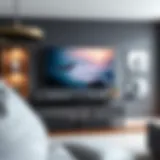The Allure of Colored Upholstered Headboards

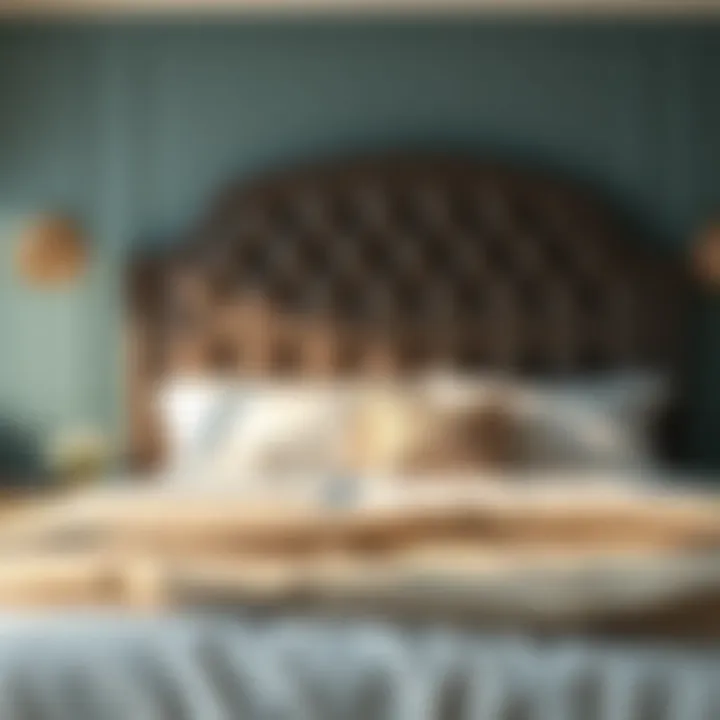
Intro
Colored upholstered headboards have become quite the sensation in recent years, transforming bedrooms into chic sanctuaries. These furnishings not only offer comfort but also infuse personality into the most intimate spaces of our homes. Gone are the days of plain, monotonous designs; homeowners are now exploring a vibrant palette, melding style and practicality. This article meticulously unpacks the elements that make these headboards alluring, from the materials that sculpt them to the psychology behind the chosen hues.
Furniture Styles and Trends
When it comes to choosing colors for upholstered headboards, understanding the furniture styles and current design trends can profoundly influence your selection.
Exploring Popular Furniture Styles
Furniture styles encompass a broad spectrum, each with its unique flair. From minimalistic Scandinavian designs emphasizing simplicity and functionality to the rich and intricate patterns found in traditional Victorian styles, there’s something for every taste.
- Contemporary: Characterized by clean lines, neutral colors often play the lead, but introducing a colored upholstered headboard can serve as a striking contrast, breathing life into an otherwise subdued setting.
- Industrial: With its raw materials and urban aesthetic, a bold red or cobalt blue headboard can add a surprising twist, enhancing the space’s edginess.
- Bohemian: Embracing free-spirited designs, this style often features eclectic combinations. A patterned headboard featuring vibrant colors and prints would integrate seamlessly into such a whimsical arrangement.
Understanding Current Design Trends
Now, let’s pivot to what’s currently trending. In recent years, there has been a noticeable shift towards personalized interiors. Homeowners are increasingly keen on making choices that reflect their identity.
"A headboard isn’t just a structural necessity; it is a canvas for self-expression."
- Sustainable Materials: A notable trend is opting for eco-friendly fabrics. Materials like organic cotton and natural linen are favored for their environmental impact and aesthetic appeal.
- Mixed Textures: Combining fabrics like velvet with cotton or leather with wool is quite on-trend. This can create a rich visual tapestry, elevating the overall look of the bedroom.
Practical Tips for Furniture Selection
Choosing the right upholstered headboard is not merely about aesthetics; it requires careful consideration of several practical aspects to ensure a harmonious fit in your space.
Factors to Consider When Choosing Furniture
- Color Palette: Choose a color that complements the room's existing hues. Think about how colors interact and influence mood. For instance, soft blues can evoke tranquility, while bright yellows can energize a space.
- Size Matters: The proportions of the headboard should match the bed and room size. A huge headboard in a small room can easily overwhelm.
- Style Harmony: The headboard should blend with existing furniture styles, creating a cohesive aesthetic.
How to Measure and Optimize Space
Before making a purchase, it’s vital to measure your space accurately. Here’s a quick guide on how to effectively gauge your requirements:
- Height and Width: Measure the bed’s width and desired height for the headboard. It should ideally be about 2-3 inches wider than the bed frame for visual balance.
- Room Dimensions: Consider the overall dimensions of your bedroom. Take note of how much space your new headboard will feature, ensuring it fits comfortably without cramping the layout.
Preamble to Colored Upholstered Headboards
Colored upholstered headboards are more than mere decorative accents in a bedroom; they represent a fusion of art and functionality that can transform the overall ambience of any space. In this article, we will explore their significance and versatility, highlighting how these headboards can reflect personal style, enhance comfort, and serve as central design elements in various interior settings.
The evolution of interior design has seen a marked shift towards the personalization of living spaces. Homeowners today are not just looking for basic furnishings; they seek pieces that resonate with their aesthetic preferences and emotional well-being. A colored upholstered headboard can do just that—it's a statement piece that captures attention, making the bed an inviting focal point. Traditionally, headboards might have been overlooked as mere necessities of a bed frame, but their fabric-covered nature invites a soft, tactile experience that heightens comfort, especially in a headstrong world of hard surfaces.
Additionally, colored headboards offer the freedom to play with vibrant hues and textures, keeping the design fresh and engaging. Whether it’s a rich navy velvet or a cheerful mustard yellow, the choice of color can influence mood and energy within the room. Color psychology suggests that certain shades can invoke feelings of calmness, creativity, or warmth, making the selection of a headboard color an important consideration for any homeowner.
Beyond aesthetics, colored upholstered headboards carry practical benefits. They can help absorb sound, contributing to a serene sleeping environment. Moreover, upholstery brings warmth and depth to a room that stark wood or metal might lack. With so many materials and colors available, it becomes clear that the benefits of choosing a colored upholstered headboard extend well beyond visuals alone.
The Historical Context of Headboards
Understanding the historical backdrop of headboards is crucial in comprehending their evolution and significance in contemporary design. From their utilitarian beginnings to the luxurious statement pieces they represent today, headboards have encapsulated changes in culture, style, and function over centuries. This exploration not only highlights the aesthetic evolution but also gives insight into the societal values and design priorities of different eras.
Evolution Through Time
The journey of headboards starts in ancient civilizations, where they served primarily practical purposes. Early headboards, often made of wood or stone, were designed to support the bedding and protrude slightly from the wall, creating a physical barrier against drafts. This was particularly vital in colder climates, where warmth was a pressing concern.
As time ticked on, headboards became more than mere functional elements. In the Middle Ages, they frequently displayed intricate carvings and religious motifs. Wealthy households adorned their bedrooms with ornate wooden headboards, reflecting the social status of the homeowner. By the Renaissance, upholstered headboards emerged, coated in lavish fabrics which hinted at a sense of comfort and luxury that had not been part of the original design.
Fast forward to the 18th and 19th centuries, and headboards became a canvas for artistic expression. The advent of new materials and manufacturing techniques allowed for greater experimentation in shape and design. A variety of styles flourished—from the sumptuous tufted velvet headboards of the Victorian era to the sleek, minimalist forms embraced by modern designers. This period marked a turning point, as headboards evolved into integral components of interior decor rather than just functional structures.
Cultural Significance
Headboards are not only functional but also deeply rooted in cultural practices and social conventions. They often serve as reflections of personal identity, family heritage, and cultural narratives. For instance, in many cultures, the design and material of a headboard can signify a family’s wealth and social standing. In contrast, simple wooden headboards might represent modesty or a return to minimalistic values.
Additionally, the headboard can be a focal point in the bedroom, symbolizing rest and relaxation, often adorned with family heirlooms or decorative textiles that carry familial narratives. The choice of color and material can embody cultural traditions and sentiments, further enriching the headboard's meaning beyond mere aesthetics.
"A headboard can tell the story of a person's journey through life, capturing moments of comfort, struggle, and self-expression."
Moreover, regional variations in headboard designs, from the elaborate wrought iron styles of the Mediterranean to the softer, plush designs found in Scandinavian décor, highlight how geography influences interior design choices. It reveals a tapestry of shared human experiences through the simple yet meaningful design of headboards.
In studying the historical context of headboards, we gain not only insights into their evolution and function but also a deeper appreciation of how these elements can transform a living space and reflect personal and cultural narratives. This historical understanding will serve as a lens through which we can explore contemporary designs, fostering a more enriched dialogue about the role of upholstered headboards in today's interiors.
Understanding Upholstered Headboards
The concept of upholstered headboards transcends mere aesthetic appeal, intertwining comfort, style, and individuality into a single piece of furniture. Understanding upholstered headboards is pivotal for anyone seeking to elevate their bedroom's ambiance. Beyond the allure of vibrant colors and textures, these headboards serve practical purposes as well. They not only provide a cozy backrest but also define the character of the room, setting the stage for the overall design narrative.
Incorporating an upholstered headboard into your living space can lead to several advantages. Firstly, these fixtures offer a unique way to express personal style. A well-chosen headboard aligns with one's taste and complements existing decor, transforming a mundane bedroom into a haven of artistic expression. Additionally, upholstered headboards are often more comfortable than their wooden or metal counterparts. They can provide a soft support for reclining, making them a popular choice for readers and those who enjoy lounging in bed.
Another important consideration is the versatility of these headboards. They can blend seamlessly into various interior themes, whether modern, classic, or eclectic. By understanding the nuances of upholstered headboards, homeowners and designers can leverage them as focal points, harmonizing textures and colors within the room.
"An upholstered headboard is not just furniture; it's a statement piece that adds a splash of personality to your bedroom."
Moreover, knowing their construction can inform maintenance choices. Upholstered headboards often are made with various materials, leading to a plethora of options in terms of durability and aesthetics. Homeowners should consider the long-term implications of fabric choice, especially in high-traffic areas or households with pets and children. Overall, understanding upholstered headboards means grasping their significance beyond convention, acknowledging them as integral elements of modern interior design.
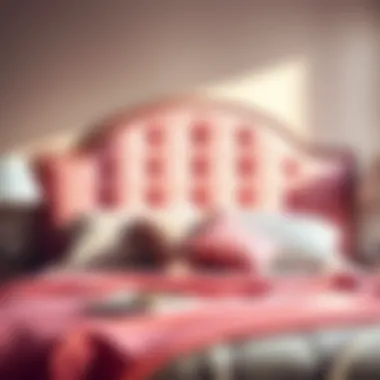
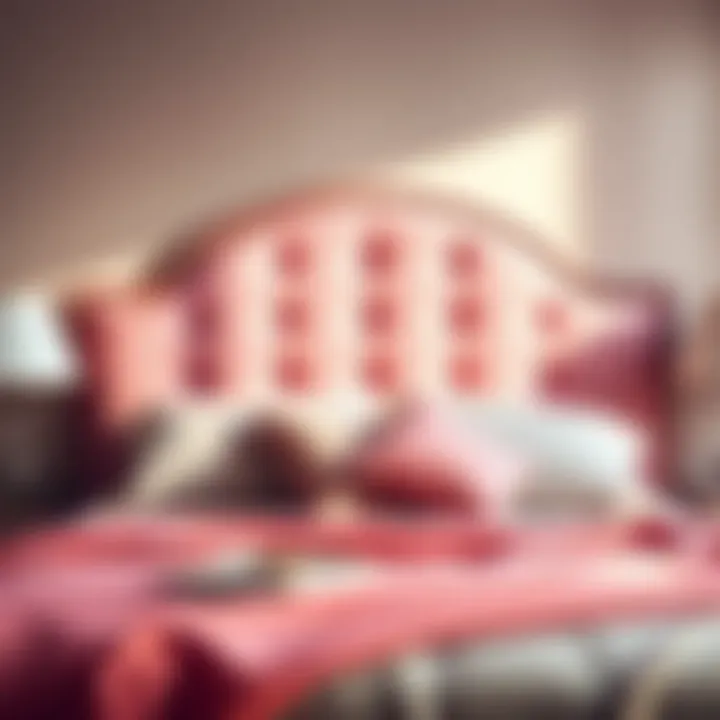
Defining Upholstery
Upholstery refers to the art of covering furniture with padded materials, such as fabric, leather, or vinyl. In the realm of headboards, upholstery serves purposes that go beyond decoration. It encompasses the materials, fillings, and techniques used, influencing both the look and feel of the piece. The choice of upholstery fabric plays a significant role, allowing individuals to create a personalized ambiance through diverse textures and colors.
When considering plush options, one may come across terms such as "button-tufted" or "smooth fabric," terms that denote techniques that define the headboard's character. Tufting, for instance, provides a classic, inviting look, while smoother finishes can lean towards sleek and modern aesthetics.
Common Fabrics Used
Various fabric types grace the realm of upholstered headboards, each presenting its own set of advantages and challenges. Below is a brief overview of some of the common fabrics used:
- Cotton: This natural fiber is breathable and easy to clean. It’s often used for casual, comfort-oriented designs.
- Linen: Known for its rich texture, linen can offer a sophisticated touch. However, it may require more maintenance due to its susceptibility to wrinkles.
- Velvet: This fabric adds a touch of luxury and depth to the design, perfect for more opulent aesthetics.
- Microfiber: This synthetic option is durable and stain-resistant, making it ideal for family spaces.
- Leather: Whether genuine or faux, leather brings a sleek appearance and is relatively easy to maintain.
Each type of fabric influences the overall sentiment of the headboard, and by choosing wisely, one can accentuate or soften the room’s overall vibe. It's crucial to balance style with practicality, ensuring that the selected fabric aligns with lifestyle needs.
The Role of Color in Design
Color is not merely a visual element or an artistic choice; it's an essential language of design that communicates mood, influences perception, and defines spaces. Within the context of colored upholstered headboards, the role of color extends beyond aesthetics to create an ambiance that resonates with the purpose of the room and the personalities of its occupants.
When selecting a headboard, understanding how color interacts with other design components is critical. A vibrant hue can energize a space, while muted shades likely promote relaxation and calmness. Moreover, color serves as a bridge, linking the headboard to broader themes in the interior design, ensuring coherence and harmony across the entire environment.
Color Psychology
Delving into color psychology reveals how each hue possesses its own distinct emotional resonance. For instance, blue often represents tranquility but may also evoke feelings of sadness in certain contexts. On the other hand, red is energetic and passionate, yet it can be overwhelming if overused. In bedrooms, where serenity and comfort should reign, neutral colors like beige or soft grey become popular choices for headboards – calming while remaining stylish.
Some specific associations include:
- Green: Symbolizes growth and tranquility, perfect for those seeking a fresh ambiance.
- Yellow: Evokes feelings of happiness, brilliant for accentuating a cheerful design.
- Purple: Often linked with luxury and creativity, it can add a touch of opulence to a space.
"Color is the keyboard, the eyes are the harmonies, the soul is the piano with many strings." - Wassily Kandinsky
This essence of color allows homeowners and designers to curate experiences that reflect individuality while considering psychological impacts. Thus, the decision on the color palette becomes more profound, rather than just a choice of trend or preference.
Choosing the Right Color Palette
When it comes to selecting a color palette, there are specific strategies to adhere to in order to ensure that a colored upholstered headboard complements the overall design scheme. Here are a few thoughtful considerations:
- Consider Room Usage: Understand how the room is used. Is it a sanctuary for rest or a lively setting for social interactions?
- Evaluate Existing Decor: Take a good look at the current colors in your decor. The headboard should ideally enhance and not clash with existing elements such as wall colors or bedding.
- Use Color Theory: Applying color theory—complementary, analogous, or triadic—helps in choosing colors that work well together. For example, an earthy green headboard pairs beautifully with rust-colored linens and warm wood tones, creating a cohesive look.
- Test Samples: Always sample before committing. Colors change in different lighting throughout the day, sometimes drastically altering their perception. One might find a shade that seemed perfect in-store looks entirely different at home.
Tailoring a color palette that resonates with the lifestyle and preferences of those using the space will ultimately set the stage for a headboard that contributes positively to the overall aesthetic and emotion of the room.
Design Trends in Upholstered Headboards
Upholstered headboards have evolved well beyond their functional roots into stunning focal points within a bedroom. As design trends shift, the importance of staying attuned to these changes becomes increasingly critical for homeowners and interior designers alike. Understanding the current design trends not only enhances aesthetic appeal but also informs practical decisions about materials, colors, and overall comfort.
Trends signify taste and can influence the resale value of a home. When a headboard mirrors contemporary styles, it can transform a space, adding character and an air of sophistication. This section will delve into the latest market preferences as well as popular styles and shapes that can redefine how we perceive bedroom design.
Current Market Preferences
Today's consumers are not just looking for functionality; they’re after pieces that exude personality and trend-savvy decisions. Various metrics indicate that sales of upholstered headboards have risen, thanks in large part to the explosion of online home decor retailers and social media platforms showcasing innovative designs.
- Layering Colors: Homeowners, particularly younger generations, are inclined to choose headboards that embrace bold hues. This trend reflects a move away from monotones, leading to a more vibrant living environment.
- Sustainable Materials: As eco-consciousness rises, there's a marked preference for headboards made from sustainable or recycled materials. Brands that promote this are gaining traction, attracting buyers who value both aesthetics and ethical considerations.
- Technology Integration: The rise in smart home technology is inspiring designers to create headboards equipped with built-in charging stations or speakers. This convergence of function and design is a strong draw for modern buyers.
These preferences indicate a shift towards personalization. Homeowners are looking for unique pieces that resonate with their lifestyle today rather than settling for traditional designs.
Popular Styles and Shapes
The array of styles and shapes present in upholstered headboards adds infinite opportunities for enhancement of a bedroom's appearance. Here are a few notable trends that are carving out their niches in the marketplace:
- Tall Headboards: These oversized options can elongate a small space, giving the illusion of higher ceilings while providing a dramatic backdrop for bedding.
- Wingback Headboards: With their iconic elevated sides, wingback designs offer a sense of coziness and luxury, making them a favored choice for those looking to create a snug retreat.
- Curved Shapes: Soft, rounded edges are emerging as popular, adding a touch of sophistication. This design also allows for greater comfort when propped up against the headboard with a book.
- Geometric Patterns: Whether through tufting or printed fabrics, unique shapes and patterns are becoming prevalent, catching the attention of those with an eye for modern aesthetics.
Market research suggests that as consumers become more confident in their design tastes, they are willing to mix and match these styles to create a truly personalized space.
"Design is not just what it looks like and feels like. Design is how it works."
– Steve Jobs
Understanding these design trends enables homeowners and designers to make informed choices. Focusing not only on the look but also on the feel and functionality of upholstered headboards can result in spaces that are not just beautiful but livable. Through exploration of current preferences and styles, one can forge a path toward creating inviting bedrooms that reflect modern sensibilities.
Practical Considerations
When it comes to integrating colored upholstered headboards into your living spaces, practical considerations can't be overlooked. These elements play a vital role in how the headboard will function, visually fit into the design scheme, and endure over time. It’s not just about aesthetics; it's important to consider sizing, scale, mounting, and installation. Getting these factors right can significantly enhance your overall interior experience while also ensuring long-term satisfaction.
Sizing and Scale
Finding the right size for your headboard is the first step in achieving a harmonious and balanced look in your bedroom. A headboard that’s too big or too small can feel out of place, throwing off the entire design of the room.
To get it just right:
- Measure Your Bed: Start by measuring the width of your bed. A common guideline is that the headboard should be at least as wide as the bed frame. This especially applies to larger beds like queen and king sizes, where a headboard can create a more expansive looking space.
- Height Considerations: The height of the headboard can also vastly change the proportions in a room. Generally, a headboard that reaches at least the height of the mattress is advisable. If you're going for a more dramatic effect, consider a headboard that extends above the bed, but be mindful of ceiling heights to ensure it doesn’t overwhelm the space.
- Design Style: The design style plays a role too. For example, a tall, tufted headboard can add a touch of elegance in a modern setting, but it may not blend well in a low-ceilinged cottage.
Balancing these factors is crucial. A well-sized headboard will help anchor the bed in the room and serve as a visual anchor that enhances the overall decor rather than detracts from it.
Mounting and Installation

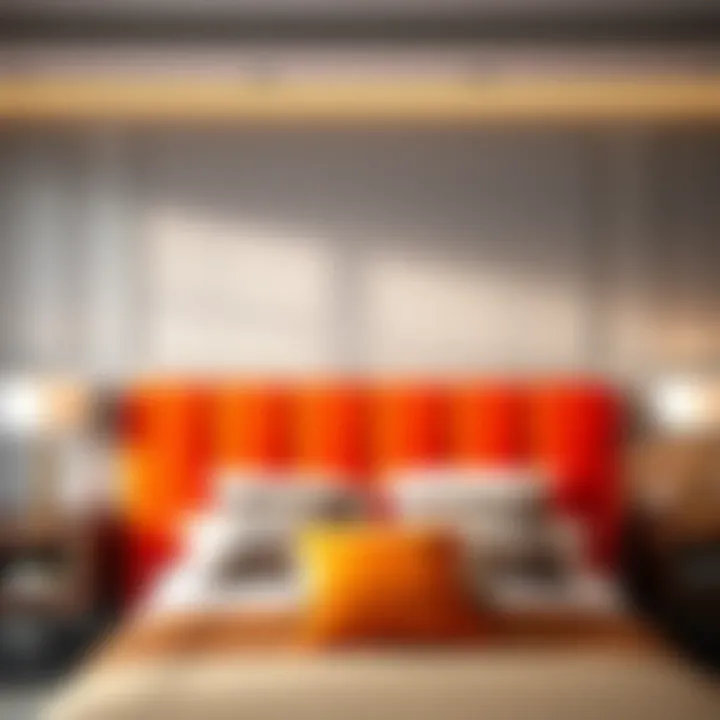
Once you’ve nailed down the sizing, it’s time to talk about the how-tos of mounting and installation.
- Freestanding vs. Wall-Mounted: Deciding between a freestanding and wall-mounted headboard can affect the installation methods and level of support needed. Freestanding headboards often require a secure attachment to the bed frame, while wall-mounted headboards need proper anchoring to the wall. For heavier options, like those made from solid wood or filled with upholstery, wall-mounting provides increased stability.
- Installation Accessories: Be sure to gather necessary tools for installing your headboard. You'll likely need brackets and screws, as well as a level to ensure the headboard is straight. Avoid half-measure installations, as a wobbly or unstable headboard can lead to issues down the line, not to mention an uncomfortable experience during use.
- Consider Professional Help: If this all sounds like too much to handle, don't hesitate to call in the pros. An experienced handyman can ensure the headboard is securely mounted and positioned to your satisfaction. It's better safe than sorry when it comes to something that will anchor your bed for years to come.
Maintenance Tips for Upholstered Headboards
When you invest in a colored upholstered headboard, you're not just buying a piece of furniture; you’re enhancing your space's aesthetic and comfort. However, without proper upkeep, even the most stylish headboard can lose its charm over time. The importance of maintenance cannot be overstated. It ensures that the vibrant colors and textures remain appealing, prolongs the life of the headboard, and ultimately safeguards your investment.
Ignoring maintenance might lead to unsightly stains, fabric wear, or a general dingy appearance. Regular attention to cleaning and protection will keep your headboard looking fresh and inviting.
Cleaning Methods
Keeping your upholstered headboard clean is essential for both hygiene and appearance. Here are some effective methods that you can employ:
- Vacuum Regularly: A vacuum cleaner with an upholstery attachment is a great first step. By doing this, you can lift dirt and dust that settles on the fabric. Aim for once a week if possible.
- Spot Clean Stains Immediately: Use a clean cloth with a mild soapy solution to dab at stains. Don’t rub, as this can spread the stain further. Testing a small, inconspicuous area first can save you from disastrous results.
- Steam Clean: For a deeper clean, consider steam cleaning. This is particularly effective for removing odors and sanitizing the fabric. Just be careful with moisture, as excessive water can warp the internal structure.
- Use Fabric Fresheners: A fabric-safe freshener can help rejuvenate your headboard, giving it a pleasant scent without the need for washing.
Protective Treatments
Once you’ve cleaned your headboard, the next logical step is protection. Here’s how you can keep your headboard looking its best:
- Stain Repellent Spray: Investing in a good quality stain repellent can make a significant difference. These sprays create a protective barrier against spills and stains.
- Cushions as Barriers: If pets are part of your household, consider incorporating cushions or blankets as additional shields. This can help mitigate wear and tear.
- Regular Maintenance Routine: Set up a bi-monthly routine to inspect your headboard. Look for loose fabric, stains, or wear and keep ahead of problems before they escalate.
"A little care goes a long way. Routine checks and cleaning can retain the magic of your upholstered headboard for years."
In essence, the maintenance of upholstered headboards involves a combination of routine cleaning and protective measures. By taking these steps, homeowners can ensure that these statement pieces not only look fabulous but also serve their purpose for a longer time. For more insights on upholstery care, consider checking resources like HOUZZ or The Spruce.
Upholstered Headboards Versus Alternatives
In today's design-savvy world, understanding the options available for headboards is critical, especially when weighing the appeal of upholstered headboards against other types. The decision between an upholstered headboard and alternatives like wood, metal, or even floating shelves hinges on various elements including aesthetics, functionality, and comfort.
Upholstered headboards stand out due to their luxurious appearance and the comfort they offer. Unlike their wooden or metal counterparts, they provide a soft surface to rest against, making them ideal for reading or watching TV in bed. The variety of colors and fabrics available means that homeowners can easily find a match or complementary design for their bedroom decor. This aspect alone makes upholstered headboards appealing not just as furniture, but as vital elements that tie a room's style together.
Comparative Analysis
To effectively compare upholstered headboards with alternatives, let’s delve into the three main contenders: wooden, metal, and hybrid options.
- Wooden Headboards
Pros:Cons: - Metal Headboards
Pros:Cons: - Hybrid Options (like wood with metal accents)
Pros:Cons:
- Sturdy and long-lasting
- Offers a classic and timeless look
- Can be painted or stained to suit different styles
- Hard surface can be uncomfortable
- Limited cushioning leads to more wear on bedding
- Often lighter and easier to move
- Can provide an industrial or modern vibe
- Low maintenance, generally leafing less dust
- Less comfortable, as they can feel cold and unforgiving
- Limited color options compared to upholstered choices
- Unique designs can blend different styles effectively
- Often combines the durability of wood with the sleekness of metal
- Still may lack the comfort factor found in upholstery
- Can be more expensive, depending on materials
In essence, while wooden and metal alternatives provide unique stylistic merits, they often fall short in terms of comfort and character compared to a well-designed upholstered headboard.
Pros and Cons
In weighing the pros and cons of upholstered headboards specifically, a thorough understanding leads to an informed choice.
Pros:
- Comfort: Soft and plush surface promotes a versatile use of the bed area.
- Customization: An endless array of colors and patterns are available, making it easy to align with one’s stylistic vision.
- Warmth: Upholstered fabrics create a cozy atmosphere, perfect for creating a restful haven.
Cons:
- Maintenance: Upholstered furniture requires more upkeep, especially in terms of cleaning to avoid stains and dust accumulation.
- Durability: While many modern upholstery brands offer resilient options, upholstered headboards can be more susceptible to wear and tear over time compared to wood or metal alternatives.
- Cost: Quality upholstered headboards can be pricier, particularly when opting for premium fabrics and custom designs.
Ultimately, the choice between upholstered headboards and their alternatives boils down to individual preferences in both style and functionality. Homeowners, designers, and decorators must consider their specific needs to optimize their living spaces in both comfort and aesthetics.
"The headboard is more than just a structural element; it’s the height of comfort and a canvas for personal style in your bedroom."
Whether embracing the soft embrace of upholstery or the steadfast sturdiness of wood or metal, each option presents its own compelling narrative within the larger story of bedroom design.
Sourcing and Customization
Sourcing and customization are vital elements to consider when choosing colored upholstered headboards. These factors influence not just the aesthetic quality of the room but also the functionality and durability of the piece itself. A headboard isn’t merely an accessory. It can serve multiple roles, from a visual focal point to a supportive element for comfort. Therefore, understanding where to source these made-to-order pieces, along with the options available for customization, can transform a simple bedroom into an inviting retreat.
Where to Buy
When it comes to sourcing colored upholstered headboards, there are several avenues available. Consider the following options for your purchase:
- Local Furniture Stores: Visiting a local store allows you to experience fabrics in person. Touching the materials gives you insights that photos online can’t.
- Online Retailers: Websites like Wayfair, Overstock, and Amazon offer a vast selection. Many online sellers provide customization options, allowing you to choose the fabric and color that best suits your design vision.
- Artisan Shops: For those seeking uniqueness, artisan shops, often found in local craft fairs or markets, sell bespoke headboards tailored to individual specifications. Craftsmanship in these pieces could align better with personal tastes.
- Custom Furniture Makers: If you have specific ideas that retail options can’t fulfill, seeking out a custom furniture maker might be the best route. They will work closely with you to turn your vision into reality, ensuring the headboard fits your exact style and size.
Whichever route you choose, consider checking ratings and reviews prior to a purchase. Understanding past customer experiences can guide your decision and help you avoid any pitfalls.
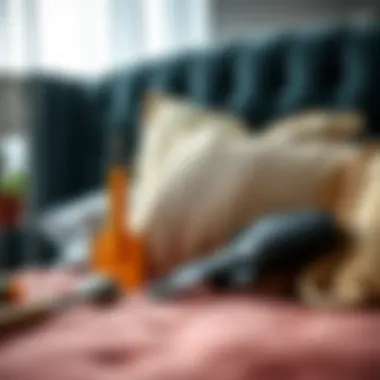

Creating Custom Designs
Customization opens the door to a world where individuality shines through. Creating a custom-designed upholstered headboard involves several steps, providing flexibility in both form and function.
- Fabric Selection: The fabric you choose can convey different moods. Do you want something soft, like velvet, or perhaps a more durable fabric like microfiber? Each fabric type carries its own benefits, so weigh your options.
- Color Choices: One might be tempted to play it safe, but think about bold colors or patterns that reflect your personality. Burnt orange or peacock blue can invigorate a neutral space, adding excitement.
- Shape and Size: Consider the scale of your headboard in relation to your bed and room dimensions. Whether you prefer a tall wingback style or a more simplified, straight-edge design matters greatly in your overall room layout.
- Additional Features: Think about including features like built-in storage or lighting. These added functionalities not only enhance the headboard's utility but elevate its design impact.
By tapping into customization, you’re not just buying a headboard; you’re investing in a unique piece that tells a story of personal expression while complementing your overall home aesthetics.
"Customization creates a connection between the object and its owner, making the headboard more than a piece of furniture. It becomes a part of the home’s narrative."
Incorporating Headboards in Diverse Interior Styles
In the realm of interior design, headboards serve as a vital element, adding both functionality and aesthetic value to bedrooms. Their significance extends beyond mere support for pillows; they shape the overall ambiance and style of a room. When you think about incorporating headboards into diverse interior styles, it's crucial to consider how color, fabric, and design harmonize with existing elements in your space. A well-chosen headboard can highlight a theme, create a focal point, or seamlessly blend in, being a silent yet impressive player in the room's design landscape.
Modern and Minimalist
The modern and minimalist approach to design is all about clean lines and simplicity. Headboards in this category should reflect these principles, often favoring subtle colors and sleek materials like leather or tailored fabrics. Neutral shades– think soft grays or warm taupes– often dominate, with occasional bold pops of color used sparingly, just to draw the eye.
In a minimalist setting, it’s essential to keep the headboard design unembellished with ornate details. Instead, focus on functionality. For instance, a low-profile headboard can enhance the space's openness, providing just enough detail without overwhelming the room. Accessories such as matching bedding or minimalist artwork can accentuate this style further.
Eclectic and Bohemian
For those leaning towards eclectic and bohemian interior styles, the headboard is where creativity truly shows its colors. This design ethos thrives on individuality and a mix of textures and patterns. Here, you'll want headboards that combine vibrant hues or unexpected materials, perhaps a fabric like velvet paired with quirky printed upholstery.
Using an oversized, tufted headboard as a statement piece can tie a room together seamlessly, reflecting the free-spirited nature that characterizes this aesthetic. The key is to embrace variety—different colors or pattern combinations—allowing the headboard to resonate with other eclectic elements in the room, such as colorful throw pillows or patterned rugs.
Traditional and Classic
The traditional and classic interior style draws inspiration from timeless elements, often favoring richer fabrics and more intricate designs. Upholstered headboards in this style often come adorned with trims, embroidery, or detailed stitching. Fabrics such as damask, brocade, or even subtle floral patterns can evoke a sense of luxury and history.
In terms of color choices, deeper and more saturated tones—like forest green, royal blue, or deep burgundy—often play well in traditional settings. An ornate wooden frame might further accentuate the headboard’s elegance, allowing it to become the centerpiece of a bedroom. When paired with wooden nightstands and classic lighting fixtures, such headboards elevate the room's sophistication, creating a warm and inviting environment.
Remember, the goal of incorporating headboards into your interior design is not just about making a choice; it’s about enhancing the narrative of your space. Every color, fabric, and form tells a story and resonates with the style you chose for your home.
Selecting the right headboard in any interior setting is a balance of aesthetic choices and practical considerations. The beauty of upholstered headboards lies in their versatility, allowing you to adapt them to suit your personal taste and the environment of the room. Whether it’s a minimalist sanctuary or a spirited bohemian space, the right headboard can make all the difference.
Impact on Room Aesthetics
When it comes to interior design, aesthetics play a crucial role in defining the atmosphere and emotional response of a space. The impact of colored upholstered headboards on room aesthetics goes beyond mere functionality; it is an essential component that can transform a bedroom from a mere sleeping area into a reflection of personal style. These headboards serve not only as practical barriers but also as significant design elements that harmonize or contrast with the overall decor.
Focal Point Creation
One of the standout advantages of incorporating a colored upholstered headboard is its ability to create a focal point within the bedroom. In a space that might otherwise feel flat or uninspired, a well-chosen headboard can draw the eye and anchor the room's design. For instance, a vividly colored velvet headboard can instantly inject drama into an otherwise neutral palette. This not only makes the bedroom more inviting but also establishes a narrative that can be complemented with other design elements such as artwork, bedding, and additional decorative accessories.
The focal point set by the headboard encourages a sense of balance; a statement piece can dictate the scale and proportions of other furnishings. Moreover, it can guide the selection of complementary colors and textures throughout the room, helping to unify the overall aesthetic.
"A visually striking headboard doesn’t just crown the bed; it crowns the entire room."
Enhancing Color Harmony
Color harmony is vital in achieving a cohesive look in any space, particularly in the bedroom where tranquility is often the goal. A colored upholstered headboard can act as the linchpin in establishing a harmonious color scheme. First, it provides an opportunity to introduce bold hues that may be too overwhelming to apply to the walls or larger pieces of furniture.
For instance, consider a soft blue or muted green headboard paired with warm neutral walls. This combination evokes a calm and refreshing feeling, suggesting a serene retreat at the end of the day. The headboard can effectively set the emotional tone, guiding the selection of bedding and accent pillows to maintain continuity.
In addition, the fabric and texture of the upholstered headboard further contribute to the aesthetic quality of color harmony. Textures like linen or suede can add depth and interest even among similar color palettes. A combination of colors and textured fabrics ensures that each element in the room speaks to one another, thereby enhancing the overall design.
In summary, colored upholstered headboards wield significant influence over room aesthetics by creating focal points and enhancing color harmony. They are not merely decorative but are instrumental in establishing a visually appealing environment that resonates with personal style and comfort. By carefully selecting headboards that align with deeper design goals, homeowners can enrich their personal sanctuaries.
The Future of Upholstered Headboards
The realm of upholstered headboards is set to witness significant transformation in the coming years. As styles evolve and lifestyles shift, the importance of understanding the future of these design staples cannot be overstated. Innovative materials, environmental considerations, and ever-changing consumer preferences are leading the charge in redefining what we expect from headboards. It’s more than just a place to lean back; it is an integral part of a room’s decor.
As we look ahead, several trends emerge that promise to reshape the market for upholstered headboards:
Emerging Trends
- Sustainability: Homeowners are now more conscious about their environmental footprint. This has sparked a notable demand for sustainable materials in home furnishings. Think organic cotton, recycled polyester, and natural woods, which are being integrated into headboard designs. This shift not only reflects a commitment to sustainability but also appeals to consumers who prioritize ethical practices.
- Smart Technology: With the rise of smart homes, there’s potential for upholstered headboards to integrate technology. Imagine a headboard with built-in speakers or USB ports, providing functionality that aligns with contemporary lifestyles. Such features could transform headboards from mere decorative elements into essential hubs of comfort and convenience.
- Personalization: More consumers are seeking products that reflect their individual style. Tailor-made upholstered headboards that allow buyers to select colors, fabrics, and shapes are on the rise. This trend signals a shift toward bespoke home design, where personal expression is paramount.
"The real beauty of modern design lies in the blend of functionality with personal expression."
Eco-Friendly Options
Environmental consciousness is not just a fleeting trend; it is a significant shift in consumer priorities. The future of upholstered headboards will likely be dominated by eco-friendly choices, which include:
- Recycled Materials: Manufacturers are now experimenting with reclaimed wood and recycled fabrics to create headboards that leave a lighter footprint on the planet.
- Natural Dyes: The use of organic and low-impact dyes is growing. This not only makes for healthier indoor air quality but also assures consumers that their choices are safe and sustainable.
- Durability: With eco-consciousness comes the desire for longevity. Future headboards will emphasize craftsmanship that ensures resilience, which results in less waste over time. A focus on durability means that consumers won't have to rush to replace worn-out items, helping to minimize landfill contributions.
The End
In tying together the themes explored throughout this article, it becomes abundantly clear that colored upholstered headboards are not merely decorative accessories; they represent a vital consideration for homeowners and interior design aficionados alike. These headboards serve multiple functions, merging aesthetics with practicality in a way that can truly transform a living space.
Value in Versatility: One crucial takeaway is the versatility that a colored upholstered headboard can bring to various interior styles—be it modern, traditional, or eclectic. This adaptability opens doors to endless design possibilities, allowing individuals to express their unique personalities through their choice of color and fabric.
Emotional Connection: Understanding the psychological impacts of color is essential when integrating a headboard into your bedroom. Colors can evoke feelings and memories, making them foundational elements in a space meant for rest and rejuvenation. Therefore, selecting a headboard that complements your emotional needs can significantly enhance your overall well-being in your home.
"Color is the keyboard, the eyes are the harmonies, the soul is the piano with many strings." - Wassily Kandinsky
Practical Considerations: Additionally, practical considerations such as sizing, maintenance, and customization options cannot be overlooked. Readers should carefully measure their spaces before purchasing, ensuring that the headboard fits seamlessly into the room's layout. Maintenance practices should also be routinely considered, to prolong the life and appearance of fabric.
Looking Ahead: Moving forward, the future of upholstered headboards is brimming with new trends, whether it be the rise of eco-friendly materials or unique, artisanal designs. For those in the market, keeping an eye on emerging styles can help tailor choices that are not only contemporary but also sustainable.










